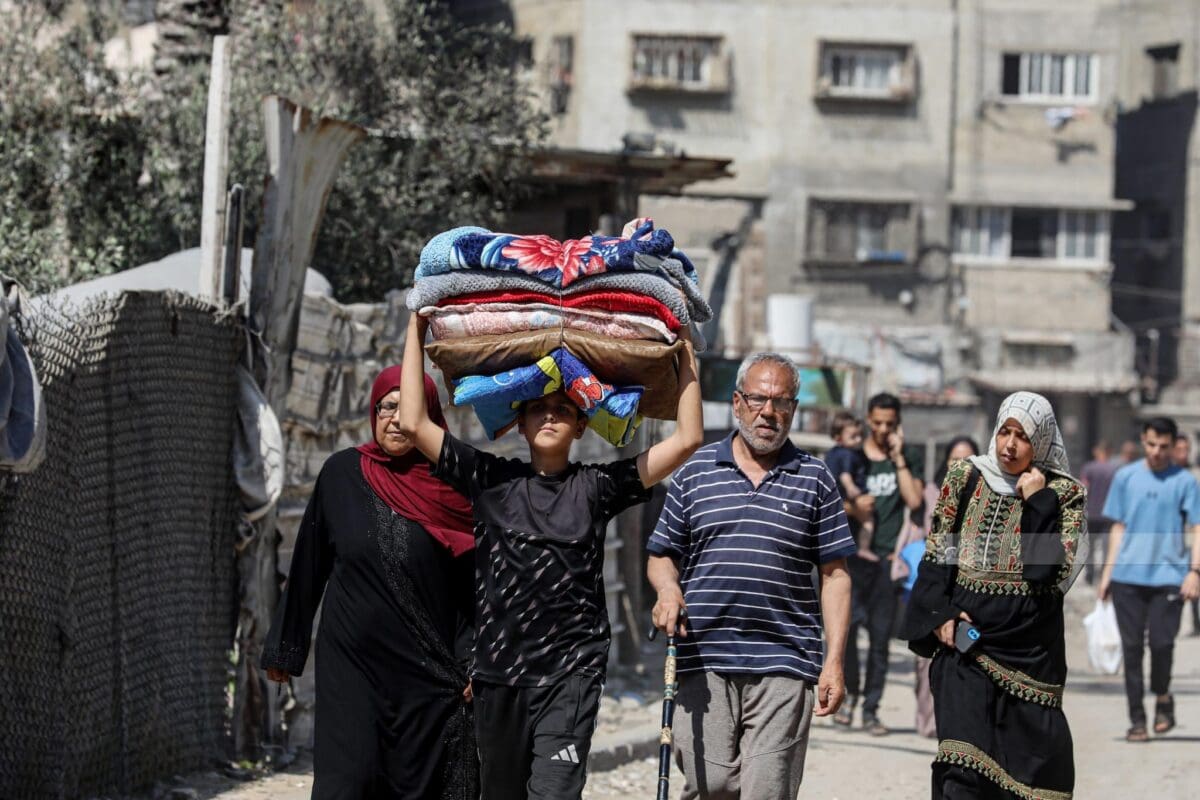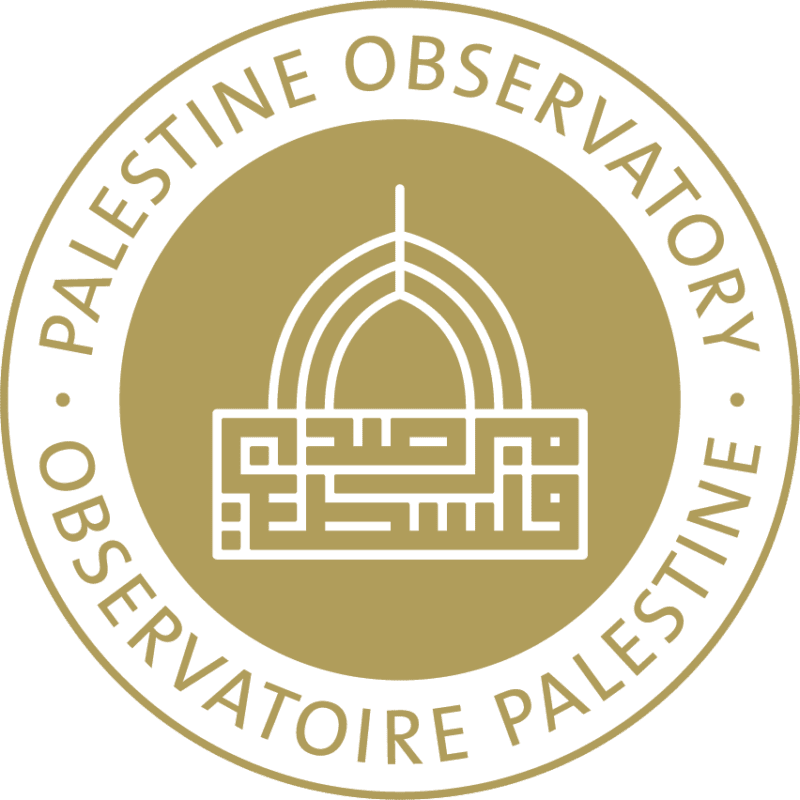“Infants’ Suffering” and “Settlement” Top the List of Israeli Occupation Crimes in Gaza and the West Bank

Palestinian civilians are being displaced from one place to another.
Palestinian News and Information Agency (PNA)
July 1, 2025
The catastrophic humanitarian situation of infants in the Gaza Strip and the ongoing settlers’ attacks on villages of the West Bank topped the bleak scene of Israeli crimes against the Palestinians, which amounted to 3496 crimes between June 24 -30, 2025. During this period, the occupation forces bombed five schools successively: “Fahd Al-Sabah School in Al-Tuffah neighborhood, Abdul Fattah Hamoud School on Jaffa Street, Osama Bin Zaid School in Al-Saftawi, Adnan Al-Alami School west of Gaza City, in addition to another school in Sheikh Radwan neighborhood,” as well as, the bombing of a popular market frequented by thousands on Jaffa Street, and a restaurant on the beach in Gaza City. Meanwhile, reports indicate that the number of Palestinians who were murdered while seeking food so far is 580, while the number of Palestinians murdered by the Israeli military machine in one week reached 536, and the number of injured reached 2116 in just one week.
The Organization of Islamic Cooperation’s Media Observatory on Israeli Crimes against Palestinians documented that, the number of Palestinians murdered by Israeli occupation forces from October 7, 2023, to June 30, 2025, reached 58,035, and 142,235 Palestinians were injured.
66 infants have also died from malnutrition in the Gaza Strip since October 7, 2023, while 70,000 infants suffer from health conditions due to chronic malnutrition. Neonatal vaccines have not been available in Gaza for four months.
The Commissioner-General of the United Nations Relief and Works Agency for Palestine Refugees in the Near East (UNRWA), Philippe Lazzarini, described the situation in the Gaza Strip as “absolutely dire,” noting that international interest and attention on Gaza has declined significantly since June 13, 2025, amid the destruction of 74% of the Strip’s water wells and the widespread suffering of its residents from contaminated drinking water.
In the West Bank and occupied Al-Quds, the number of incursions carried out by Israeli occupation forces in one week reached 279, during which one child was murdered and nine others were arrested, out of a total of 216 Palestinian detainees. The Israeli occupation forces also raided a school in the village of Jalud and confiscated surveillance camera footage.
Despite the reopening of the gates of Al-Aqsa Mosque, occupation forces have prevented Waqf employees from entering the Noble Sanctuary, while settlers continue to intrude.
The Israeli occupation forces issued an order to confiscate more than two dunums of land in the town of Ya’bad in Jenin, seized five vehicles and money, demolished four homes in Al-Quds and Jenin, and occupied three homes in Nablus and Jenin. They also demolished a number of commercial stores in Jenin, a car wash, and an agricultural nursery in the town of Kafel Haris in Salfit, as well as, two pens in Dura al-Qar’a in Ramallah, and the village of Wadi Rahhal in Bethlehem, water wells, and bulldozed agricultural lands.
Settlement activities in towns and villages across the West Bank reached 15 during the week, focusing on confiscating Palestinian lands in the Masafer area of Yatta, the area between the settlements of Ibei Hanahal and Ma’ale Amos in the Bethlehem area, the road adjacent to Wadi Azriq in the town of Hizma in Al-Quds, in addition to areas of adjacent land, and the Jabal al-Masalma area in the village of Raba in Jenin, all for the benefit of settlement projects.
In the same context, the occupation forces set up three mobile homes north of the city of Salfit, bulldozed agricultural lands in the village of Husan near the junction of the “Beitar Illit” settlement, uprooted dozens of olive trees, and transferred 12 mobile homes to the new settlement outpost on Mount Al-Kadan from the lands of the town of Kafr Qaddum. The settlement was named “Gideon Neighborhood” affiliated with the “Kedumim” settlement, and 10 settler families were housed there. Settlers fenced off lands near Palestinian tents in the Al-Farisiya area of Tubas, and lands between the villages of Qaryut and Jalud in Nablus. They also bulldozed lands, paved a road, and uprooted olive trees west of the village of Deir Ammar in Ramallah, and agricultural lands in the town of Aqraba in Nablus. They uprooted olive trees to seize the land, bulldozed lands planted with olive, almond, and grape trees, and filled in water collection wells with the aim of expanding the “Daniel” settlement in the Shoshala area, located south of the town of Al-Khader. Settlers set up tents on Palestinian land south of the village of Asira al-Qibliya in Nablus, and other tents on Palestinian land near the settlement of Karmei Tzur in the Hebron area. They vandalized a water well and established a new settlement outpost near Arab al-Ka’abneh in the Wadi al-Qelt area west of Jericho.
The OIC Observatory recorded 70 settler attacks on Palestinian towns and villages in just one week. The most notable was the raid on the village of Kafr Malik in Ramallah, which resulted in the murder of three Palestinians, the wounding of ten others, and the burning of ten vehicles. Settlers attacked a Palestinian home, smashed its windows, and stole property in the Masafer area of Yatta in Hebron. They also stormed the outskirts of the town of Al-Mazra’a Al-Gharbiya in Ramallah, stole a number of gas cylinders from a store, and destroyed a sign for Al-Quds Water Authority at the entrance to the water stations in the Ein Samia area of Ramallah. They stole a horse in the village of Wadi Fukin in Bethlehem, and released their cattle in the Arab Al-Malihat area in Jericho. They burned a vehicle and Palestinian property, grazed their cattle on Palestinian agricultural land, cut tree branches, and seized a water well in the Masafer area of Yatta. Settlers stormed the village of Susya in Hebron, burned agricultural land on the outskirts of the village of Asira Al-Qibliya and the village of Yatma in Nablus, and uprooted 260 trees in the town of Aqraba in Nablus and the town of Azzun in Qalqilya, and other trees in the town of Turmus Ayya in Ramallah. They demolished a barn in the town of Yatta and burned a hut in the village of Hizma. In Al-Quds.
